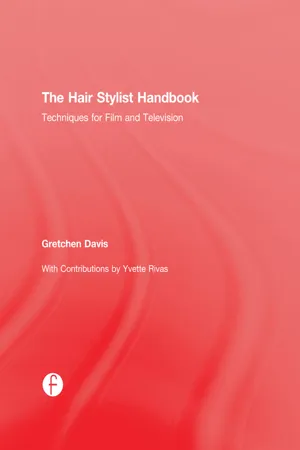![]()
Chapter One
Anatomy
Movie and video hair stylists are creative forces to be reckoned with. Creative thinking outside the box goes a long way for this exclusive group of men and women. With individualistic artistic talent, hair stylists mold, shape, cut, and manipulate hair to create images that may linger for ever in your memory. In film, hair stylists are asked to do just about anything and everything. Those requests from actors, writers, directors, and producers span the spectrum from beauty to special effects through all media. As a multi-media hair stylist, you’ll encounter many situations that require knowledge of facial anatomy, as well as the structure of the hair follicle. For example, you might encounter diseases, inflammation, burned or broken follicles while working with an actor. You could be asked to create or fit a wig, extensions, or visually reshape the head using these items. Sadly, problems often arise for hair stylists who are just beginning their career, and that’s why it’s important that professional hair stylists know how to solve unexpected problems quickly. Experienced hair stylists know how to correctly decide what styles, hairpieces, or products work best under different circumstances.
“The impulse behind our interest is the urge both to locate an invisible ‘self’ beneath the skin and to ‘read’ what the surface appearance tells us.”
Sandra Kemp, Future Face, p. 35.
Starting with the skeletal system, hair stylists should focus on understanding what is holding and shaping the head. The head in its most basic form includes your sensory organs: the nose, ears, skin, and eyes. The skull protects the brain. For hair stylists, the occipital and parietal bones and the crown have the most impact in determining cutting, styling, or applying hair-like extensions. Head shapes determine what styles work best for the individual.
The skull is often used by makeup artists for anatomically correct measurements for beauty or effects makeup.
The skull is in two parts.
The neurocranium protects the brain, and forms the base of the skull. Eight bones form the cranium: the occipital, sphenoid, frontal, ethmoid, two parietal and two temporal bones.
The viscerocranium is the facial skeleton. The facial skeleton consists of nasal and oral cavities, mandible, vomer, maxilla, palatine, nasal, zygomatic, lacrimal, conchae, and inferior nasal bones.
Medical science tells us the epidermis helps the skin protect us from diseases and other biological threats and retains water. Also, layers of fat in the skin help to retain energy while holding in heat. The skin is the largest organ of the body. Hair is made up of proteins and amino acids. Hair grows down into the dermis, originating from the epidermis. As cells form, older hair is pushed outward. As hair grows it goes through keratinization, a process by which epithelial cells lose their moisture and are replaced by horny tissue. Proteins in hair are bonded by amino acids known as polypeptides, and polypeptides in different states allow us to manipulate hair by blow drying, using irons, or tinting, for example.
Figure 1.1 Skull anterior
A professional hair stylist should know what happens to hair when cut, plucked, or chemically removed. Will the hair grow back quickly? Has the hair been damaged? Will cutting hair make it grow faster? There are several factors involved in how hair grows back, or grows back texturally different. Hair can also grow back much slower or not at all.
Hair growth happens in four phases. Anagen is the phase in which hair grows. Depending on heredity, environment, or chemical abuse, hair can grow at a fast pace, or stop growing at a certain length. This phase can last two to eight years. Catagen is a transition between active growth and rest. Telegen is the phrase at which hairs are dead, and shedding can occur daily. This phase lasts between two to four weeks. Lastly, exogen is a phase in which several hairs in one follicle are shed.
Figure 1.2 The skin and hair growth
Figure 1.3 Hair structure
Hair is often admired for its color. But hair fibers have no color. Cells produce pigments called melanin, the same chemical that colors our skin. Cells (melanocytes) are found in the dermis (skin), but also in the bulb of hair follicles, so that pigments are distributed to growing hair.
How is this done? Simply put, keratinocytes produce hair fiber that contains melanosomes, that in turn form color.
Head Shapes
Figure 1.4 Proportions of the head
“There is certainly no absolute standard of beauty. That precisely is what makes its pursuit so interesting.”
John Kenneth Galbraith
Men’s and women’s face shapes are generally the same. Men tend to sway towards a more macho appearance, and their hair styles and facial hair will often reflect this.
“It’s not uncommon for people to have a combination of face and head shapes. Most importantly it was observed that the proportion of the features were nearly identical on everyone regardless of sex or nationality.”
William L. Maughan, Drawing the Head, p. 60
Skeletal, head, and neck shapes will influence the way you cut, style, or color hair, although for film and television you’ll probably be styling most often for a specific character. For example, the crown or top of the head is seen in a variety of shapes. A flat top (crown) would need more volume on top. How the head curves downward forming a parietal ridge determines head shapes such as round or square. Jennifer Stanfield, makeup artist for films like San Andreas and The Hobbit trilogy says, “When creating looks for period pieces, head and face shapes can differ. Fuller appearances are achieved through shading, highlighting, hair color, extensions, and wigs.” Your personal evaluation and experience will be a deciding fa...





